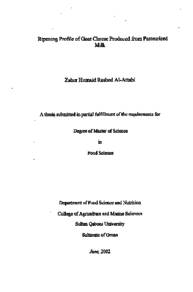Document
Ripening profile of goat cheese produced from pasteurized milk
Publisher
Sultan Qaboos University
Gregorian
2002
Language
English
Subject
English abstract
The present study analyzed microbial groups, physico-chemical characteristics, proteolysis, lipolysis and rheological properties over a 30-day ripening period of a standard semi hard cheese made from pasteurized goat's milk. The cheese was manufactured from pasteurized milk by a standard method and ripened over a 30-day period at controlled temperature and humidity.
The microbial groups of technological interest (aerobic mesophilic , flora, lactococci, lactobacilli, micrococcaceae, coliforms and molds and yeasts) were enumerated. With the exception of coliforms and micrococaccacea, high counts of all other microbial were observed. The total bacteria counts were high in cheese throughout ripening, with lactic acid bacteria being the main microbial group. Total and faecal coliforms were completely absent throughout ripening indicating that they do not play any role in the development of the cheese characteristics. Microcaccacea showed initial low counts but maintained their levels relatively constant during the ripening period.
The main biochemical modification of cheese during ripening was related to the extent of proteolysis. The water soluble nitrogen (WSN) and non-protein nitrogen (NPN) (trichloroacitic acid nitrogen (TCAN)) in the semi hard cheese increased during ripening; after 1 month, the percentage of (WSN) was 40.6 % and the NPN fraction accounted for 11.04 % of the total nitrogen. Lipolysis was insignificant and remained constant throughout the ripening period studied. The total FFA content at the end of ripening was 9.87 g oleic acid / 100 g fat. A fast decrease in the pH of the cheese was observed during the ripening period.
The rhelogical study suggested that the most important factors that may influence the texture of the goat cheese is the level of total solids and the extent of protein degradation recorded as soluble nitrogen during the ripening period. Rheological properties of goat's cheese showed a transformation from a soft and elastic consistency to a hard and brittle body as a function of aging from day 8 to day 30 of production.
This study will contribute to the general knowledge of cheese made of pasteurized goat's milk. It also will help the Omani farmers to apply the new technology of making cheese and to control the conditions of production and storage.
Member of
Resource URL
Arabic abstract
حلت الأطروحة الحالية المجموعات الميكروبية، الخصائص الفيزيوكميائية، عملية تحطم البروتينات، تحلل الدهون و مبحث الانسياب خلال 30 يوما للجبن شبه الصلب ذات المعيار و المصنع من حليب العنزة المبستر. جبن العنزة صنع من الحليب المبستر بطريقة قياسية ونضج على فترة 30 يوم في درجة الحرارة والرطوبة المحكمة.
المجموعات الميكروبية ذات الاهتمام التقني ( البكتيريا الهوائية التي تنمو في درجة حرارة متوسطة، لاکتوكوكسي، لاكتوباسيلاي، ميكروکوکسي، کولیفورم و الخمائر و العفن قد عددت. باستثناء کولیفورم ومیکروکوکسي، مجاميع عالية من كل المجموعات الميكروبية الأخرى قد لوحظت. مجاميع البكتيريا الكلية كانت عالية في الجبن خلال عملية الإنضاج، بالبكتيريا الحامضة اللبنية التي تكون المجموعة الميكروبية الرئيسية. بكتيريا الكوليفورم كانت غائبة كليا خلال عملية الإنضاج، إشارة إلى أنهم لا يلعبون أي دور في تطور خصائص الجبن. لوحظ أن مجاميع میكروكوكسي كانت منخفضة اوليا و لكن حافظت على مستوياتهم ثابتة بشكل نسبي خلال فترة النضوج التعديل البيوكيمياوي الحيوي الرئيسي للجبن خلال النضوج ارتبط بمدى تحطم البروتينيات. النيتروجين القابل للذوبان في الماء و النيتروجين غير البروتيني في الجبن نضف الصلب زاد خلال عملية النضوج، بعد شهر واحد، النسبة المئوية للنيتروجين القابل للذوبان في الماء كانت 40 . 6%، والنيتروجين غير البروتيني 27 . 2 % من المجموع الكلي للنيتروجين. عملية تحلل الدهون كانت غير مهمة وبقيت ثابتة خلال فترة النضوج. مجاميع الأحماض الدهنية الحرة بقيت ثابتة في نهاية النضوج وكانت 9 . 87g لكل g100 دهن. لوحظ خلال فترة النضوج تناقص سريع في معدل حموضة الجبن.
دراسة مبحث الانسياب اقترحت أن العوامل الأكثر أهمية التي ربما تؤثر على قوام جبن العنزة هو مستوى المواد الصلبة ومدی تحطم البروتين، كالنيتروجين قابل للذوبان خلال فترة النضوج. خصائص مبحث الانسياب لجبن العنزة بينت التحول من قوام ناعم ومطاطي إلى جسم صلب وهش بسبب التخمر من اليوم 8 إلى اليوم 30 من الإنتاج. هذه الأطروحة سوف تساهم في زيادة المعلومات حول الأجبان و خصوصا تلك المصنعة من حليب العنزة. كذلك سوف تساعد المزارعين العمانيين الصغار في تطبيق التكنولوجيا الحديثة والتحكم جيدا في ظروف الإنتاج و التخزين.
المجموعات الميكروبية ذات الاهتمام التقني ( البكتيريا الهوائية التي تنمو في درجة حرارة متوسطة، لاکتوكوكسي، لاكتوباسيلاي، ميكروکوکسي، کولیفورم و الخمائر و العفن قد عددت. باستثناء کولیفورم ومیکروکوکسي، مجاميع عالية من كل المجموعات الميكروبية الأخرى قد لوحظت. مجاميع البكتيريا الكلية كانت عالية في الجبن خلال عملية الإنضاج، بالبكتيريا الحامضة اللبنية التي تكون المجموعة الميكروبية الرئيسية. بكتيريا الكوليفورم كانت غائبة كليا خلال عملية الإنضاج، إشارة إلى أنهم لا يلعبون أي دور في تطور خصائص الجبن. لوحظ أن مجاميع میكروكوكسي كانت منخفضة اوليا و لكن حافظت على مستوياتهم ثابتة بشكل نسبي خلال فترة النضوج التعديل البيوكيمياوي الحيوي الرئيسي للجبن خلال النضوج ارتبط بمدى تحطم البروتينيات. النيتروجين القابل للذوبان في الماء و النيتروجين غير البروتيني في الجبن نضف الصلب زاد خلال عملية النضوج، بعد شهر واحد، النسبة المئوية للنيتروجين القابل للذوبان في الماء كانت 40 . 6%، والنيتروجين غير البروتيني 27 . 2 % من المجموع الكلي للنيتروجين. عملية تحلل الدهون كانت غير مهمة وبقيت ثابتة خلال فترة النضوج. مجاميع الأحماض الدهنية الحرة بقيت ثابتة في نهاية النضوج وكانت 9 . 87g لكل g100 دهن. لوحظ خلال فترة النضوج تناقص سريع في معدل حموضة الجبن.
دراسة مبحث الانسياب اقترحت أن العوامل الأكثر أهمية التي ربما تؤثر على قوام جبن العنزة هو مستوى المواد الصلبة ومدی تحطم البروتين، كالنيتروجين قابل للذوبان خلال فترة النضوج. خصائص مبحث الانسياب لجبن العنزة بينت التحول من قوام ناعم ومطاطي إلى جسم صلب وهش بسبب التخمر من اليوم 8 إلى اليوم 30 من الإنتاج. هذه الأطروحة سوف تساهم في زيادة المعلومات حول الأجبان و خصوصا تلك المصنعة من حليب العنزة. كذلك سوف تساعد المزارعين العمانيين الصغار في تطبيق التكنولوجيا الحديثة والتحكم جيدا في ظروف الإنتاج و التخزين.
Category
Theses and Dissertations

